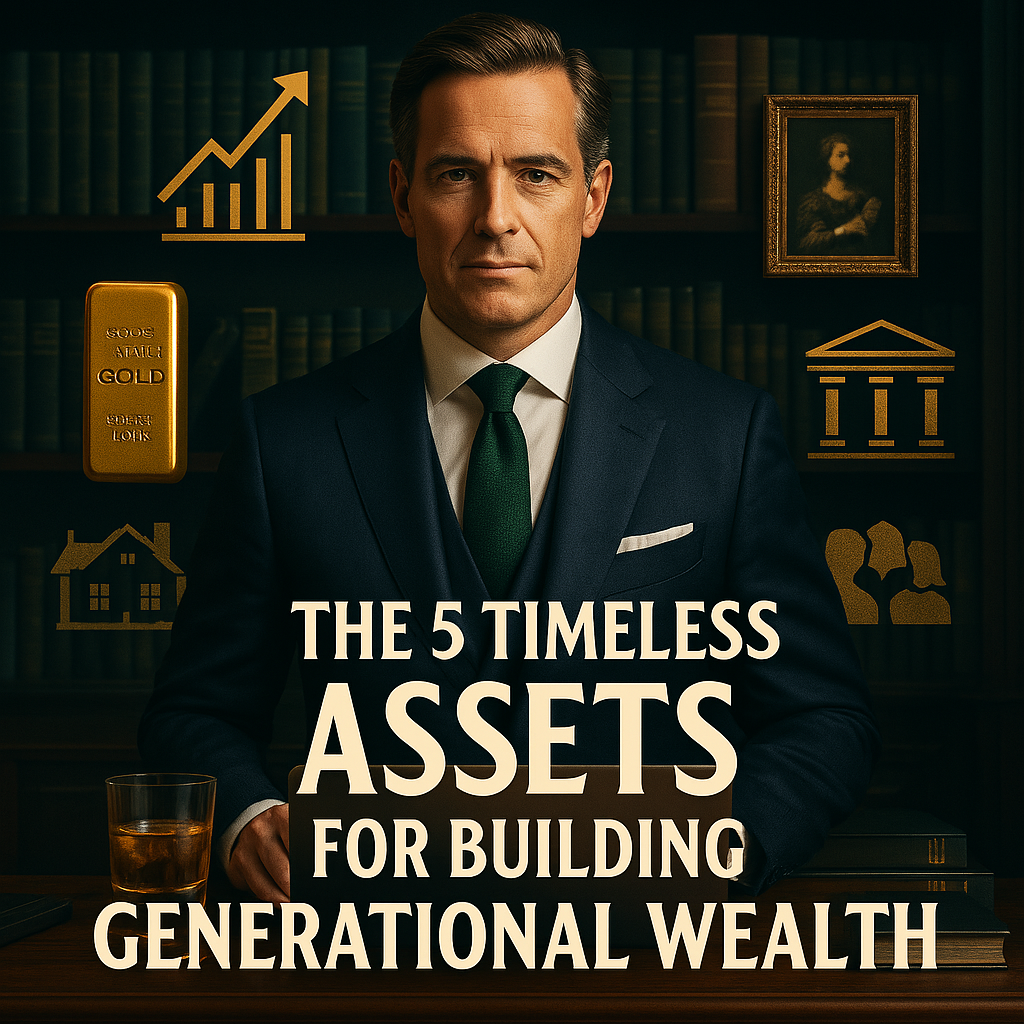The 5 Timeless Assets for Building Generational Wealth
The 5 timeless assets for building generational wealth have consistently proven their worth throughout human history, standing strong through wars, economic collapses, and revolutionary changes.
As an economics professor with decades of experience studying wealth preservation, I’ve observed how certain investments consistently outperform others when measured across generations rather than quarters.
The ability to build wealth that transcends your own lifetime requires strategic investment in assets that have demonstrated remarkable stability despite turbulent global events.
Many investors focus on short-term gains, but the truly wealthy understand that generational prosperity requires patience and investment in assets with proven longevity.
When examining historical wealth patterns across centuries, five particular asset classes emerge as superior stores of value that resist devaluation and often appreciate substantially over extended timeframes.
These five assets should form the foundation of any serious long-term wealth building strategy designed to benefit not just yourself but future generations of your family.
The most successful family dynasties throughout history have relied on these exact investments to preserve and grow their wealth across multiple generations, even during periods of significant economic and political upheaval.
Understanding why these assets maintain their worth over decades and centuries provides critical insight for anyone seeking to build lasting financial security in an increasingly uncertain world.
We strongly recommend that you check out our guide on how to take advantage of AI in today’s passive income economy.
Table of Contents
1. Real Estate: The Cornerstone of Generational Wealth
Real estate consistently ranks as the most powerful wealth-building asset in human history, and for good reason.
Unlike many investments that exist merely on paper or in digital form, real estate serves a fundamental human need that never disappears – shelter.
The timeless necessity of housing ensures that regardless of economic conditions, real estate in desirable locations will always retain significant value, making it an unparalleled foundation for generational wealth.
Even during market downturns when prices temporarily decline, well-positioned real estate invariably recovers and continues its upward trajectory over extended timeframes.
The unique characteristic of real estate as both a financial asset and a basic human necessity creates a remarkable stability that few other investments can match.
Real estate offers investors exceptional control over appreciation through strategic renovations, professional management, and development options that can substantially increase property values beyond market trends.
The supply and demand dynamics that have driven real estate values for centuries show no signs of changing, with population growth and urbanization continuing to create housing shortages in desirable areas.
For multi-generational wealth planning, real estate provides unmatched stability, potential for passive income, and significant appreciation over decades.
Historical Performance and Accessibility
Real estate stands out among investment options for its remarkable accessibility to investors at various economic levels.
Unlike some sophisticated investment vehicles that require specialized knowledge, real estate concepts are generally easier to understand and implement successfully for the average person.
The historical performance of residential real estate illustrates its exceptional wealth-building potential – the median single-family home in the United States sold for approximately $165,000 in the early 2000s, while today that same property would be valued around $420,000.
This substantial appreciation doesn’t even account for the additional benefits of rental income that investment properties can generate throughout the holding period.
Real estate also provides practical utility during ownership – either as personal shelter for your family or as income-producing rental property that essentially pays for itself while appreciating.
Savvy investors recognize that real estate represents both financial security and practical necessity, creating a unique dual-purpose asset class unmatched by other investments.
The combination of appreciation potential, income generation, tax advantages, and fulfillment of basic needs makes real estate an essential component of any serious generational wealth strategy.
Individuals who delay real estate investment often find themselves at a significant disadvantage compared to those who prioritize property ownership as the foundation of their wealth-building approach.
2. Land: The Truly Finite Asset
Land represents perhaps the most fundamentally limited resource on our planet, with implications that make it exceptionally valuable for generational wealth preservation.
The finite nature of land creates an inherent scarcity that undergirds its persistent value – unlike virtually every other asset class, no new land can be manufactured or created.
This immutable limitation on supply coupled with ever-increasing demand from growing populations ensures that land maintains and increases its value across generations regardless of economic fluctuations.
While stocks, cryptocurrencies, and even buildings can multiply, deteriorate or become obsolete, land itself remains permanently valuable and useful regardless of what happens above or below its surface.
Certain categories of land – particularly waterfront properties, urban centers, and resource-rich areas – possess even greater scarcity value due to their unique characteristics and utility for human civilization.
Global population trends indicate continuing urbanization and concentration in specific geographic regions, intensifying competition for desirable land and driving values progressively higher over time.
Unlike constructed assets that require constant maintenance and eventually deteriorate, raw land requires minimal upkeep while maintaining or increasing its worth through societal development around it.
Land’s permanent nature makes it the quintessential multi-generational asset, capable of providing financial security for families across centuries rather than mere decades.
The Strategic Advantages of Land Ownership
Land ownership provides exceptional flexibility and strategic advantages for wealth preservation across generations.
Even completely passive land investment – purchasing and simply holding undeveloped property without any improvements – can yield substantial returns as surrounding development increases property values without any active investment.
Government infrastructure projects, private development in adjacent areas, and urban expansion can dramatically increase land values without requiring any action from the landowner.
For more active investors, land offers multiple revenue streams through leasing to farmers, businesses, or developers while retaining the underlying asset and its appreciation potential.
Land’s versatility allows it to be repurposed for various uses as economic conditions change, providing adaptability that few other investments can match across generational timeframes.
During periods of financial instability, land ownership offers significant leverage opportunities and security compared to more volatile paper assets that may rapidly lose value.
Historically, land values have consistently outpaced inflation, making land ownership an effective hedge against currency devaluation and monetary policy fluctuations.
Even seemingly unremarkable parcels can become extraordinarily valuable as development patterns shift – former agricultural land on city peripheries frequently transforms into lucrative commercial or residential property within a single generation.
3. Art: The Alternative Banking System for Wealth Preservation
Art has served as a sophisticated wealth preservation vehicle for centuries, though its financial significance often remains underappreciated by mainstream investors.
The exceptional durability of art as a store of value stems largely from its existence outside conventional financial systems and its independence from government policies, corporate performance, or inflation.
Unlike standardized financial instruments, art valuation operates on unique principles that provide significant advantages for generational wealth preservation across economic cycles and political changes.
The absence of standardized valuation metrics for artwork creates both complexity and opportunity – while stocks have clear earnings reports and real estate has comparable sales data, art’s value derives from more subjective factors including provenance, cultural significance, and collector demand.
This subjective valuation model allows art to maintain value even during periods when traditional financial markets experience severe disruption or devaluation.
Despite being relatively illiquid compared to publicly traded securities, fine art maintains financial utility through its acceptance as collateral for secured loans, enabling owners to access capital without divesting their appreciating assets.
The regulatory and tax advantages of art ownership provide additional benefits for wealth preservation, including specialized storage options in freeport facilities where valuable collections can remain exempt from certain taxes and duties.
For families focused on multi-generational wealth strategies, art provides a unique combination of cultural significance, financial appreciation, and insulation from conventional market risks.
Art as an Investment Class
Sophisticated investors recognize that while art doesn’t generate cash flow like dividend stocks or rental properties, its appreciation potential frequently outperforms traditional financial instruments over extended timeframes.
Works by established artists with historical significance have demonstrated remarkable price stability and growth, with masterpieces by creators like Picasso, Van Gogh, and Basquiat consistently increasing in value regardless of broader economic conditions.
The previously exclusive world of fine art investment has become increasingly accessible through fractional ownership platforms that allow individuals to purchase shares of museum-quality artwork without requiring millions in capital.
These innovative investment vehicles democratize access to an asset class that has historically provided exceptional returns – art as an investment category has outperformed the S&P 500 over the past thirty years despite significant market volatility.
Recent technological advances in authentication, provenance tracking, and fractional ownership have further strengthened art’s position as a practical component of comprehensive wealth preservation strategies.
The emotional and cultural value of art provides an additional dimension of worth beyond pure financial considerations, creating an asset that families can genuinely appreciate while it appreciates financially.
As long as human civilization values creativity, cultural heritage, and aesthetic achievement, fine art will maintain its position as a premier store of value across generations.
For diversified wealth preservation strategies designed to withstand economic upheaval, political change, and generational transfers, quality artwork remains one of the most reliable and historically proven asset classes available.
4. Blue-Chip Stocks: Owning the Economic Engine
While individual companies rise and fall, ownership stakes in the dominant corporations that power global commerce have consistently preserved and grown wealth across generations.
The largest, most established companies represent essential components of modern civilization – providing technologies, services, and products that have become fundamentally integrated into daily life worldwide.
Unlike smaller or newer companies vulnerable to market trends and disruption, blue-chip corporations like Apple, Microsoft, Google, and Amazon have developed near-monopolistic positions in their respective sectors.
These dominant market leaders have demonstrated remarkable resilience through economic downturns, using their substantial resources and market power to adapt, innovate, and frequently emerge stronger from periods that destroy their smaller competitors.
The essential nature of the services provided by these companies – from operating systems and cloud computing to search engines and e-commerce infrastructure – ensures continued demand regardless of economic conditions.
During economic contractions, these corporate giants typically view market weakness as strategic opportunity, acquiring innovative competitors, expanding market share, and positioning themselves for the next economic expansion.
The transformative capacity of leading corporations to evolve their business models in response to technological and market changes provides a durability that more static investments cannot match.
For generational wealth planning, ownership in these economic powerhouses offers both growth potential and relative stability compared to more speculative investments or companies with less dominant market positions.
Remarkable Returns Over Time
The historical performance of market-leading companies illustrates the extraordinary wealth-building potential of long-term equity ownership in dominant corporations.
A single share of Amazon purchased at its 1997 IPO price of approximately $1.50 has since appreciated to around $196, representing growth that dramatically outpaces almost all other asset classes over the same period.
Similar performance can be observed with Apple stock, which traded below $1 per share in 2000 (adjusted for splits) and now commands over $200 per share – a return that would have transformed modest investments into multi-generational wealth.
These examples demonstrate that patient capital deployed in market-leading companies can produce returns that substantially exceed inflation, interest rates, and most alternative investments over extended timeframes.
The compound growth potential of reinvested dividends further enhances the wealth-building capacity of blue-chip stocks held across decades rather than traded frequently.
While stock prices invariably fluctuate in the short term, ownership in companies that provide essential services and products has proven remarkably resilient when measured across generational timeframes.
For family wealth preservation strategies spanning multiple decades, a carefully selected portfolio of dominant corporations in essential industries provides both growth potential and relative stability.
The historical record clearly demonstrates that despite periodic market corrections and economic cycles, patient investors in market-leading companies have consistently built substantial multi-generational wealth.
5. Precious Metals: Civilization’s Oldest Store of Value
Gold and silver have maintained their status as premier stores of value across millennia, outlasting countless civilizations, governments, and currency systems.
The enduring worth of precious metals stems from their unique combination of scarcity, utility, beauty, and independence from any single economic or political system.
Unlike stocks that depend on corporate performance, real estate that requires functioning markets, or currency that relies on government stability, precious metals maintain intrinsic value regardless of human institutions.
Throughout recorded history, gold and silver have served as reliable safe havens during periods of war, economic collapse, currency devaluation, and political upheaval.
The inherently limited supply of precious metals creates natural resistance to devaluation through inflation – unlike fiat currencies that can be printed without limit, gold and silver cannot be created by government decree.
During periods of financial instability, precious metals typically experience counter-cyclical price increases as investors seek assets with intrinsic value independent of the financial system.
The physical properties of gold and silver – durability, divisibility, portability, and resistance to corrosion – have made them ideal stores of value throughout human history.
For multi-generational wealth preservation strategies, precious metals provide insurance against systemic economic risks that can severely impact other asset classes.
Institutional Recognition and Modern Relevance
The enduring value of precious metals receives powerful validation through their continued usage by central banks and governments worldwide as official reserve assets.
Major economic powers including the United States, China, Russia, and Germany maintain substantial gold reserves as foundational components of their national financial security strategies.
This institutional commitment to precious metals ownership demonstrates their continued relevance even in an era of digital currencies and sophisticated financial instruments.
For private investors focused on multi-generational wealth preservation, the same qualities that make precious metals attractive to governments – stability, portability, and independence from counterparty risk – provide similar benefits.
While precious metals may not deliver the dramatic growth potential of successful equity investments during economic expansions, they have consistently preserved purchasing power through periods that decimated other asset classes.
The combination of historical performance, institutional adoption, and inherent physical properties ensures that precious metals remain relevant components of comprehensive wealth preservation strategies.
In a world of increasing financial complexity and interconnected risks, the simplicity and proven track record of precious metals provide a stabilizing foundation for family wealth designed to span generations.
For investors seeking to construct truly resilient multi-generational wealth portfolios, precious metals offer unique protective qualities that complement more growth-oriented assets during inevitable periods of economic turbulence.
Building Multi-Generational Wealth: The Long View
Constructing wealth designed to endure across generations requires fundamentally different thinking than strategies focused on short-term gains or market timing.
Truly successful multi-generational wealth building prioritizes assets with demonstrated longevity, resilience through economic cycles, and inherent utility that ensures continued demand regardless of changing fashions or technologies.
The five asset classes examined – real estate, land, art, blue-chip stocks, and precious metals – have consistently demonstrated these essential qualities across centuries of economic evolution and upheaval.
Each asset category offers distinct advantages and protective characteristics that become particularly valuable during different economic conditions, providing natural diversification for family wealth preservation.
Real estate and land deliver both appreciation potential and practical utility, blue-chip stocks offer growth through economic expansion, art provides cultural value and inflation protection, while precious metals offer insurance against systemic risks.
The complementary nature of these assets creates resilience against unpredictable future developments – while specific economic conditions may temporarily impact one asset class, others frequently provide offsetting stability or growth.
Historical patterns clearly demonstrate that wealth built on these foundational assets has withstood wars, depressions, political revolutions, currency collapses, and technological transformations that destroyed other forms of wealth.
For families serious about creating lasting financial legacies, these five timeless assets should form the core of investment strategies designed to preserve and grow wealth across multiple generations.
Beyond Accumulation: The Preservation Mindset
Building truly multi-generational wealth requires moving beyond the accumulation mindset that focuses primarily on growing assets to a preservation perspective that emphasizes longevity, stability, and resilience.
While accumulating assets represents an essential first step, protecting that wealth against inflation, taxation, political uncertainty, and economic volatility becomes increasingly important as family wealth grows across generations.
The most successful multi-generational wealth strategies incorporate robust diversification across these proven asset classes rather than concentration in currently fashionable investments lacking historical validation.
Patient capital deployed strategically across real estate, land, art, blue-chip equities, and precious metals has demonstrated remarkable durability through economic environments that destroyed more speculative forms of wealth.
Examining historical wealth patterns reveals that families who successfully preserved assets across three or more generations typically prioritized these timeless investments rather than chasing temporary market trends.
The psychological discipline required for truly long-term investing – measuring success in decades rather than quarters – represents perhaps the greatest challenge for most investors conditioned to expect immediate results.
Families who develop this multi-generational perspective gain significant advantages through compound growth, strategic timing of market cycles, and the ability to capitalize on distressed asset prices during periodic economic downturns.
By focusing on assets with proven longevity and inherent utility, investors can construct wealth designed not merely to survive but to flourish across generations regardless of unpredictable economic, political, and technological changes.

We strongly recommend that you check out our guide on how to take advantage of AI in today’s passive income economy.




